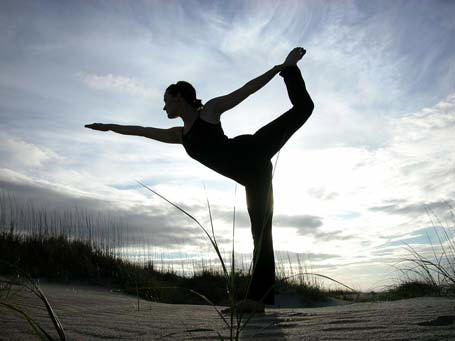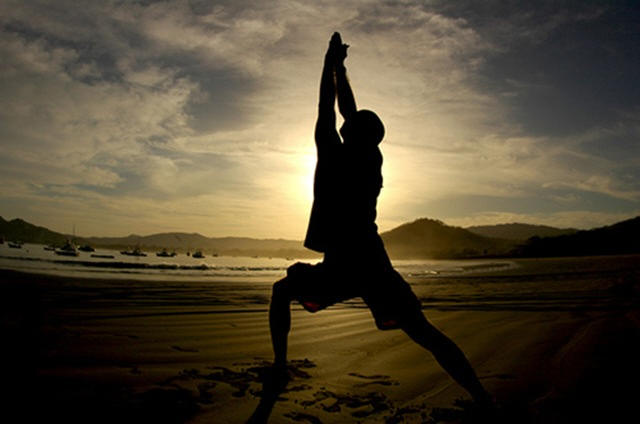|

Recognized as one of the finest boutique beach resorts in in kerala,Pozhiyoram
Beach Resort, is dedicated to promoting the authentic spiritual tradition of
Ayurveda and Yoga in an environment, union with the mother nature.
The emphasis is to live an ashram style life (daily yoga, meditation sessions,
chanting classes, authentic kerala food, community service, exploring the
villages) in private, serene and traditional accommodation and facilities. At
the Yoga Retreat, guests can learn and practice different facets of Yoga - for
physical strength, balance and flexibility, for physiological & therapeutic
benefits and if they are interested, for pursuing a spiritual path through
various types of meditation. In addition to this, guests of the Boutique Resort
can join our chef for cooking classes, interact with local villages and
learning the rich traditions, art forms such as Kathakali, Baratanatyam etc.
Guests at Pozhiyoram also get a unique opportunity to experience living a
yogic lifestyle along with the Pozhiyoram staff, who are all trained in every
aspect of Yoga. You can also commune with the local community, participate in
the village school activities and get an insight into their lives. The Ayurveda
centre at Pozhiyoram aims to provide our guests with rejuvenation massage
therapies drawn from the ancient traditions of India.
The staff at Pozhiyoram all endeavor to embody the spiritual tradition of
Athithi devo Bhava (serving the Guest as an embodiment of the Divine)
Yoga Processes
Ashtanga Yoga
Yoga is more than just a physical discipline. It is a way of life—a rich
philosophical path. And the yamas (restraints) and niyamas (observances) are ten
good common-sense guidelines for leading a healthier, happier life for bringing
spiritual awareness into a social context. They are for you to think about and
ponder over with a rational mind, because yoga is not about mindlessly accepting
externally imposed rules—it is about finding the truth for yourself—and
'connecting' with it.
Yamas:
There are many interpretations of and opinions about the yamas and niyamas.
While the ancient Indian text, the Bhagavata Purana assigns 12 yogic restraints
the Parashar Smriti, another text, puts forward ten. But the yamas as described
in Patanjali's Yoga Sutra are only five, which are also known as the great
universal vows or the sarvabhauma maha vratas, because they are not limited by
either class, creed, time or circumstances. They are the guidelines for how we
interact with the outer world, the social disciplines to guide us in our
relationships with others.

These five are:
• Ahimsa (non-violence),
• Satya (truthfulness),
• Asteya (non-stealing),
• Brahmacharya (celibacy) and
• Aparigraha (non-covetousness)
According to the Yajnavalkya Samhita, ahimsa or non-violence is the awareness
and practice of non-violence in thought, speech and action. It advocates the
practices of compassion, love, understanding, patience, self-love, and
worthiness.
Patanjali describes truthfulness as: "To be in harmony with mind, word and
action, to conduct speech and mind according to truth, to express through speech
and to retain it in the intellect what has been seen, understood or heard." A
perfectly truthful person is he who expresses in his speech exactly what he
thinks in his mind and in the end acts according to it.
Non-stealing or asteya is the third constituent of the yamas of Ashtanga Yoga.
It upholds forgoing the unauthorized possession of thought, speech and action.
Asteya stands against covetousness and envy. It advocates the cultivation of a
sense of completeness and self-sufficiency in order to progress beyond base
cravings.
The Vedas, Smritis and Puranas all glorify the fourth constituent of celibacy.
It is believed to be a behavior, which brings man nearer to the Divine. This
yama believes in avoiding all sensual pleasures, whether mental, vocal or
physical.
The literal meaning of apigraha, the fifth yama, is the non-accumulation of
worldly objects, caused by covetousness and attachment. The commentator Vyasa
says that this last state of yama is attained when one remains totally detached
from sensual pleasures of all kinds and so effectively refrains from committing
himsa or violence of any sort.
Niyamas:
The niyamas are the second constituents of Ashtanga Yoga. How we interact with
ourselves, our internal world. The niyamas are about self-regulation—helping us
maintain a positive environment in which to grow. Their practice harnesses the
energy generated from the cultivation of the earlier yamas. According to sage
Yajnavalkya, there are ten niyamas and the Bhagavad Gita lists 11 constituents.

But
Patanjali names only five:
• Shaucha or purity,
• Santosha or contentment,
• Tapa or austerity,
• Swadhyaya or self-education and
• Ishwar-Pranidhan or meditation on the Divine
Shaucha implies both external as well as internal purity. In the words of sage
Manu, water purifies the body; truthfulness the mind; true knowledge the
intellect and the soul is purified by knowledge and austerity. It advocates the
practices of intellectual purity, purity of speech and of the body.
The second niyama is that of contentment, which is described as not desiring
more than what one has earned by his honest labor. This state of mind is about
maintaining equanimity through all that life offers. Santosha involves the
practice of gratitude and joyfulness—maintaining calm at all costs. This state
of mind does not depend on any external causes.
Austerity, the third niyama, is described in Yoga philosophy as power to stand
thirst and hunger, cold and heat, discomforts of place and postures, silent
meditation and ritual fasts. It also maintains that the perfect man is he who
practices both mental as well as physical austerity.
According to the commentator Vyas, self-education or swadhyaya consists of
scriptural studies. The scripture being, the Vedas and Upanishads together with
the recitation of the Gayatri Mantra and the Om mantra.
Commentators describe Ishwar-Pranidhan, the last of the niyamas, as the
dedication of all our actions, performed either by intellect, speech or body, to
the Divine. The results of all such actions are by definition, therefore,
dependent upon Divine decision. The mortal mind can simply aspire to realize the
Divine through dedication, purification, tranquilization and concentration of
the mind. This Divine contemplation spills over to all aspects of the yogi's
life.
The Benefits of Practicing Yamas and Niyamas:
The yamas and niyamas help in managing our energy in an integrative manner,
complementing our outer life to our inner development. They help us view
ourselves with compassion and awareness. They help in respecting the values of
this life, in balancing our inner growth with outer restraint. In short they
help us to lead a conscious life.
Yamas and niyamas are not about right and wrong. They are about being honest
with the true Self. Living according to these principles are about living our
lives in a better way, about moving towards an understanding, about making it
possible to 'connect' with the Divine.
|
A yogasana is a posture in harmony with one's inner consciousness. It
aims at the attainment of a sustained and comfortable sitting posture to
facilitate meditation. Asanas also help in balancing and harmonizing
the basic structure of the human body, which is why they have a range of
therapeutic uses too.
Functions of
Yogasanas
Asanas basically perform five functions:
• Conative,
• Cognitive,
• Mental,
• Intellectual and
• Spiritual.
Conative action is the voluntary exercise of the organs of action. The
asanas being the main yogic instrument of balancing the body, they
consist of various physical postures, which are designed to release tension,
improve flexibility and maximize the flow of vital energy. The purpose of
the asanas is to create a flow of positive energy so that our
concentration is directed within ourselves and the mind is able to perceive
(parokshya jnana) the effects of our purposive action. That is
cognitive action.
When the earlier two actions are
fused, our mind's discriminative faculty guides these organs to perform the
asanas more correctly. The resultant rhythmic energy flow and
awareness leads to a mental state of pure joy (ananda). Physical
postures, therefore, end up affecting the various interrelated channels (nadis)
of the mind-body complex. And ultimately the performance of a perfect
yogasana leads to the absolute intellectual absorption of the mind on a
single task (dharana), which in turn leads to the fusion of the
individual spirit with the Divine Self (dhyana). |
|
Benefits
of Yogasanas
The regular practice of yogasanas has an immense amount of
therapeutic value. Besides various physiological benefits, they positively
affect our minds, our life force energies as well as our creative
intelligence.
Regular practice helps to keep our body fit, controls cholesterol level,
reduces weight, normalizes blood pressure and improves heart performance.
Physical fitness thus achieved leads to reduction of physical stress and
greater vitality. Asanas harmonize our pranic ability and mental
energy flow by clearing any blockages in the subtle body leading to mental
equilibrium and calmness. They make the mind strong thus enabling our human
body to suffer
pain and unhappiness stoically and with fortitude.
Various Categories of Yogasanas
Consummate mastery over the entire gamut of asanas is no doubt
time-consuming, but what is of vital importance is the will to remain in the
present moment and to let both the mind and body relax completely.
The various categories of asanas are:
• Standing Asanas,
• Forward Bending Asanas,
• Supine Asanas,
• Inverted Asanas,
• Abdominal and Lumbar Asanas,
• Twisting Asanas,
• Back Bending Asanas and
• Balancing Asanas.
Standing Asanas:
Beginners should start with these as they bring elasticity in joints and
muscles and build up stamina and physical stability. This constitutes the
most basic training in the early stages of yoga practice. Some basic
standing poses are,
Tadasana
Utthita Trikonasana, Virabhadrasana,
Ardha Chandrasana and
Utthita Parsvakonasana.
Forward Bending Asanas:
In these postures the posterior half of the body is stretched. These prepare
you to proceed further in yoga and bring consistency in the development of
physical and mental pliability. Examples of such asanas are,
Upavisthakonasana and
Paschimotanasana.
Sitting and Supine Asanas:
Sitting upright and supine extending positions help a sadhaka prepare
physically and mentally for pranayama. Some of them are,
Baddhakonasana,
Supta Baddhakonasana,
Supta Padangusthanasana, Padmasana, Vajrasana,
Simhasana,
Virasana and so on.
Inverted Asanas:
These help recover from everyday stress. They give vitality, mental balance
and emotional stability. These are
Adho Mukha Svanasa and
Urdhva Mukha Svanasa.
Abdominal and Lumbar Asanas:
These tone and massage the abdominal organs and strengthen the pelvic and
lumbar areas.
Bharadvajasana and
Marichyasana are some examples of such asanas.
Twisting Asanas:
It consists of lateral stretching and twisting of the spine, toning the
internal organs and reaching new horizons while tranquilizing the mind.
These are, Ardha Matsyendrasana and Jathara Parivartanasana.
Back Bending Asanas:
These bring physical and mental sharpness and alertness. The postures are
the opposite of forward bends as are the effects. In forward bends the
posterior spine is extended, bringing consistency and mental peace, whereas
in back bends the anterior spine is extended and stretched. The effect is
invigorating and enlivening. Such asanas are,
Ustrasana, Bhujangasana and Matsyasana.
Balancing Asanas:
These strengthen the arms and wrists and exercise the abdominal organs. They
also make the body feel light and help attain a good bearing.
Salamba Sirsasana,
Niralamba Sarvangasana and
Salamba Sarvangasana are some of the balancing asanas. |
|
'Pranayama' is a compound term ('prana' and 'yama')
meaning the maintenance of prana in a healthy throughout one's life. More
than a breath-control exercise, pranayama is all about controlling
the life force or prana. Ancient yogis, who understood the essence of prana,
studied it and devised methods and practices to master it. These practices
are better known as pranayama. Since breath or prana is basic to
life, the practice of pranayama helps in harnessing the prana in and
around us, and by deepening and extending it, pranayama leads to a
state of inner peace.
According to Hatha Yoga, pranayamas can be classified under:
• Sahita Kumbhaka,
• Surya Bhedi,
•
Ujjayi,
• Sitali,
• Bhastrika,
• Bhramari,
• Murchha and
• Kewali.
The first is a breath retention
technique, which gives agility, strength and flexibility to the body. They
also quieten the mind and the sense organs besides enabling the meditator to
control his hunger and thirst.
The Surya Bhedi pranayama consists of inhaling through the right
nostril and exhaling through the left. This practice promotes good digestion
and through perspiration, it purges the body of all its impurities.
Ujjayi pranayama involves the travel of breath between the nose and
the heart only. It acts like an expectorant and increases digestion together
with removing all impurities of nerves as well as thoughts.
Bhramari pranayama
involves a very concentrated and fixed breathing exercise. It helps in
strengthening one's breath besides quietening the mind and increasing the
powers of concentration. This breathing technique is very helpful in the
last meditative stage of samadhi.
Murchha pranayama
is an extreme form of breath retention, which only experienced yogis can
achieve. This practice quietens the mind and helps it to reach the
near-unconscious state.
The last technique of Kewali
pranayama, is a breath retention technique in which, the yogi stops both
inhalation as well as exhalation. This form balances inhalation and
exhalation besides helping the mind to concentrate better.
|
|
Benefits
of Pranayama
The practices of pranayama—the correct breathing technique helps to
manipulate our energies. Most of us breathe incorrectly, using only half of
our lung capacity. Pranayama is a technique, which re-educates our
breathing process, helps us to release tensions and develop a relaxed state
of mind. It also balances our nervous system and encourages creative
thinking. In addition, by increasing the amount of oxygen to our brain it
improves mental clarity, alertness and physical well being.
When practiced along with yogasanas the benefits of pranayama
are more pronounced. According to Patanjali's Yoga Sutra, pranayama
enables the mind to acquire the capacity to concentrate on any given object
of attention. It also says that scientific breathing helps in unveiling true
knowledge from the darkness of ignorance. But it is eminently advisable to
be aware of all the
do's and don'ts of pranayama before practicing them.
Various Stages of Pranayama
The following are the stages of pranayama:
• Inhalation or puraka,
• Exhalation or rechaka,
• Stambhavritti pranayama and
• Bahyabhyantarakshepi pranayama.
Puraka or inhalation techniques are about regular and controlled
inhalation. It also teaches regulating the entire breathing process and
reducing the number of inhalations per minute. Rechaka or exhalation
exercises teach slow and ordered breathing besides reducing the number of
inhalations and exhalations per minute. The third stage consists of
retaining the breath after stopping natural inhalation and exhalation. The
last stage of pranayama is about converting both exhalation and
inhalation into retention and storing the retained breathe in various
internal organs for various lengths of time. |
|
Pratyahara involves rightly managing the senses and going beyond them
instead of simply closing and suppressing them. It involves reining in the
senses for increased attention rather than distraction. Pratyahara
may be practiced with mantra meditation and
visualization techniques.
Benefits of Pratyahara
It is essential to practice pratyahara for achieving the three
meditative stages of dharana, dhyana and samadhi.
Perfecting this technique of yoga is also essential in order to break out
from the eternal cycle of rebirths.
|
|
The last three limbs of Ashtanga Yoga are the three essential stages
of meditation.
Dharana involves developing and extending our powers of
concentration. This consists of various ways of directing and controlling
our attention and mind-fixing skills, such as concentrating on the chakras
or turning inwards.
|
|
Dhyana is the state of meditation, when the mind attains the ability
to sustain its attention without getting distracted. Strictly speaking,
unlike the other six limbs of yoga, this is not a technique but rather a
state of mind, a delicate state of awareness. This state rightfully precedes
the final state of samadhi. |
|

Samadhi, or total absorption, is the ability to become one with the
True Self and merge into the object of concentration. In this state of mind,
the perceiver and the object of perception unite through the very act of
perception—a true unity of all thought and action. This is the acme of all
yogic endeavors—the ultimate 'yoga' or connection between the
individual and the universal Soul!
Patanjali's Yoga Sutra categorizes and grades the levels of
samadhi in the first chapter or
Samadhi Pada:
• Samprajnata Samadhi or distinguished contemplation and
• Asamprajnata Samadhi or non-distinguished contemplation,
• Savitarka Samadhi or deliberated absorption and
• Nirvitarka Samadhi or non-deliberated absorption,
• Savichara Samadhi or reflective meditation and
• Nirvichara Samadhi or non-reflective meditation,
• Sabija Samadhi, where the mind continues to carry seeds of earthly
impressions and
• Nirbija Samadhi, where each seed of earthly impressions have been
erased.
|
|




